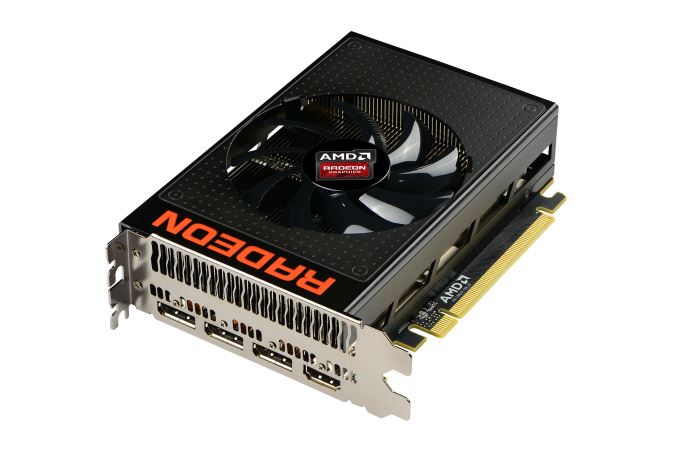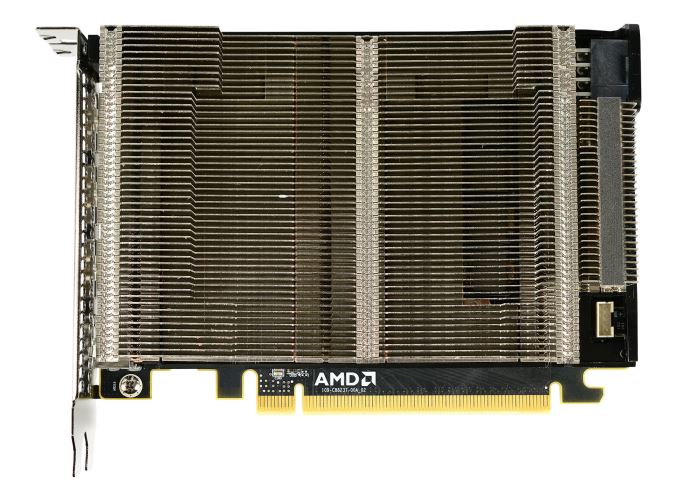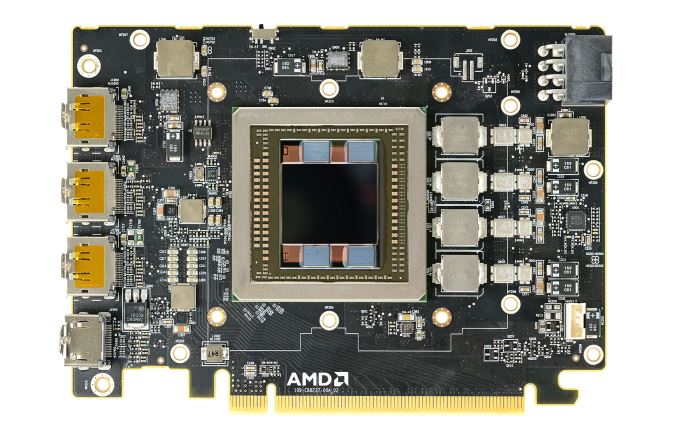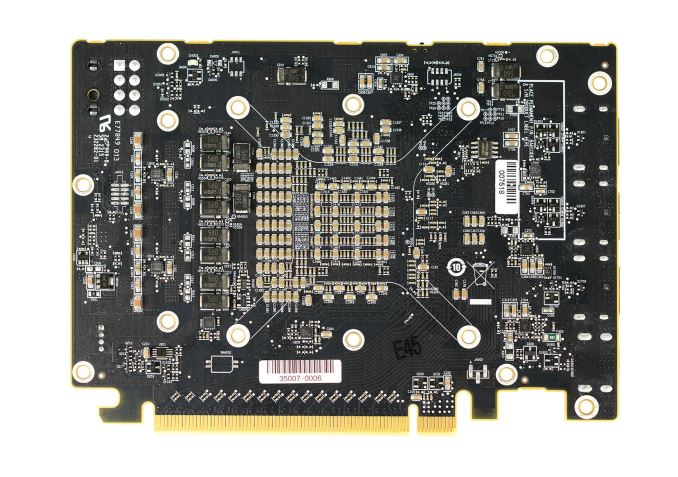The AMD Radeon R9 Nano Review: The Power of Size
by Ryan Smith on September 10, 2015 8:00 AM ESTMeet The Radeon R9 Nano
6 inch video cards are by no means a new thing in the GPU space, however these are traditionally lower-end products that need neither a large cooler nor an extensive power delivery system. As a result the R9 Nano is something of an interesting aberration, packing a lot more power and a lot more technology into half a foot of video card than what we normally see.
Starting as always from the top, the R9 Nano measures 6” long, which is actually a bit shorter than the full length the Mini-ITX standard allows. Responsibility for cooling the card falls to the R9 Nano’s new open air cooler, an aggressive design that has been specifically tailored to allow the card to effectively dissipate 175W of heat in such a small space.
The overall design of the R9 Nano’s cooler is best described as a combination open-air and half-blower hybrid. The design is technically open-air, employing a single axial fan to cool the card. However with only a single fan AMD has been able to align the heatsink fins horizontally and then place the fan in the center of the heatsink. The end result is that roughly half of the heat produced by the card is vented outside of the case, similar to a full blower, while the other half of the heat is vented back into the case. This reduces (though doesn’t eliminate) the amount of hot air being recycled by the card.
The heatsink itself is composed of aluminum and runs virtually the entire length of the card. This is technical a two-piece heatsink, with the primary heatsink composing the bulk of the card, while a much smaller secondary heatsink it found towards the far end of the card and mounted on top of a heatpipe.
Drilling down, we find that the primary heatsink is fed by a combination vapor chamber and heatpipe design. A copper vapor chamber serves to draw heat away from the Fiji GPU and HBM stacks, and then heatpipes are used to better distribute heat to the rest of the heatsink. The use of a vapor chamber in the R9 Nano makes a lot of sense given the fact that vapor chambers are traditionally the most efficient heatsink base type, however the R9 Nano is also unique in that we typically don’t see vapor chambers and heatpipes used together. Other designs such as the high-end GeForce series use a single large vapor chamber across the entire heatsink base, so among reference cards at least the R9 Nano stands alone in this respect. In this case given AMD’s design goals for size and noise, a vapor chamber will play a big part in helping the small card effectively and quietly dissipate 175W.
As for the physical PCB itself, as we can see AMD made it a relatively packed card in order to get the R9 Nano down to 6 inches. Compared to the R9 Fury X reference board, the biggest change here is that AMD has removed a fair bit of power circuitry to save space. By our count there are 4 VRM phases to feed the Fiji GPU, as opposed to the 6 found on R9 Fury X. Power delivery is handled by a single 8-pin PCIe power socket, which is becoming increasingly common, replacing the 2x 6-pin setup for 150W-225W cards.
Meanwhile to further shrink the overall PCB footprint, AMD has moved some of the remaining power delivery circuitry to the back of the card. The front of the card still contains the inductors and heat-sensitive MOSFETs, while a number of capacitors are on the rear of the card (and is why you won’t find a backplate).
Finally, for display I/O R9 Nano is unchanged from R9 Fury X. This means we’re looking at a DVI-free design, with 3x DisplayPort 1.2 and 1x HDMI 1.4 port all along a single row of the I/O bracket. Buyers looking to put together HTPCs will want to be especially mindful of the HDMI 1.4 port; while it's not necessarily a deal-breaker, it does mean that the R9 Nano can't fully drive 4Kp60 TVs, which are slowly but surely becoming more common.
Overall AMD is rather confident in their design for the R9 Nano. The heatsink is built to efficiently dissipate more heat than the 175W the card requires (despite the small size), and as a result we never see the R9 Nano thermally throttle under normal operation. The card’s thermal throttle point is 85C, and in our testing the card never passed 75C, exactly as AMD promised us. What ends up limiting the R9 Nano’s performance then is exactly as expected: the power throttling.
















284 Comments
View All Comments
D. Lister - Sunday, September 13, 2015 - link
The Fermi architecture did indeed have those flaws, not to mention the thermal issues of the 4xx family and the strict power budget of the 5xx series that Nvidia stupidly enforced on its partners. The latter resulting in CTD in the factory overclocked models in some poor PC ports like Crysis 2, where the only solution was to downclock the GPU to its reference state. But despite such rare lapses, Nvidia has evolved steadily, and every generation has rectified the flaws of its predecessor, and improved in terms of features, power usage and temps.Oxford Guy - Tuesday, September 15, 2015 - link
Don't forget the driver that bricked Fermi cards.D. Lister - Sunday, September 13, 2015 - link
@medi03Sorry, but that nonsense just doesn't cut it anymore. Not after so many years of the same fraudulent babble going on over and over.
If someone "uneducated" was told that product A and product B both performed the same, yet product A could be bought for less money, than most people would go for product A.
If that is not happening than obviously there is more to this than purely performance/dollar(*), and the market is a lot more educated in the year 2015 than your fanboy delusions would've led you to believe.
Honestly, you AMD fanatics are like the Westboro Baptist Church of technology. I wouldn't be surprised if you lot started picketing outside the Intel and Nvidia HQs with "God hates Intel/Nvidia" placards.
*-Sadly, thanks to that HBM gimmick, AMD doesn't even have the performance/dollar feature anymore. The Nano's MSRP equals the 20-30% stronger 980Ti's retail value, and because of its rarity, actually is more expensive than the 980Ti.
medi03 - Monday, September 14, 2015 - link
I don't recall talking about "performance dollar", why do you have to lie like that? Is that your imagination?There were CLEAR, HANDS DOWN cases of inferiour products, be it nVidia's Fermi chips, or Intel's Prescott P4 fiasco outselling the competitor. That shows how much clue our "uneducated" public has. End of story.
Now take a deep breath and think if you really have some argument.
D. Lister - Monday, September 14, 2015 - link
"I don't recall talking about "performance dollar", why do you have to lie like that? Is that your imagination?"Tsk, tsk, "reading" is obviously not your strong suite.
"There were CLEAR, HANDS DOWN cases of inferiour products, be it nVidia's Fermi chips, or Intel's Prescott P4 fiasco outselling the competitor. That shows how much clue our "uneducated" public has. End of story."
That's your argument? Really? Where can anyone actually even buy Prescotts or Fermis these days? Who is buying them? In those times AMD's market share was significantly higher than it is now and quite rightfully so, rendering your abysmal argument completely moot. And the story didn't end there you silly little man - after Fermi there was Kepler, and then Maxwell. After Prescott there were over a dozen processor families, each and every single one an improvement, not just in raw performance but also in performance/watt and performance/dollar.
Granted that AMD has had improvements as well, but thanks to the terrible decisions of the businessmen at the top (e.g. selling their foundries and getting ATI for a lot more than it was worth, not focusing on their primary markets and losing loyal fans to other companies, etc.), not to mention the terrible software support for often very decent hardware and regularly over-promising and under-delivering, they are where they are now. The facts are ultimately in the ledgers, and mindless corporate drones like yourself can make up absurd stories and conspiracy theories as much as you like - fact is that AMD is dying and as their funds keep shrinking, so does the overall quality of their products, especially compared to the competition.
"Now take a deep breath and think if you really have some argument."
All I can do is shake my head and smile sadly at how completely you miss the irony in your statement. It's okay, once AMD is inevitably ripped apart and its pieces consumed by the corporate sharks and the AMD and Radeon brands are reduced to forgotten footnotes in tech history, cretins like you will find something else to fill the void in your pathetic, pointless existence. Have a nice life, if you can, I'm done with you.
D. Lister - Monday, September 14, 2015 - link
Just to make it very clear (again) to any AMD fans that may feel my sentiments to be overtly harsh towards their favored company, I personally believe that whatever has happened to AMD in the last decade or so, is nothing short of a heart-breaking tragedy, where the business fat cats at the top repeatedly made poor short-term decisions and exploited the hard work of brilliant engineers and technicians, giving themselves and their marketing lackeys bigger paychecks while the R&D starved, resulting in AMD as a company never truly reaching its full potential. And we all, as consumers and enthusiasts are worse off for it.Oxford Guy - Tuesday, September 15, 2015 - link
Too bad for that summary that it ignores the well-made products that AMD's customers have enjoyed and the industry has benefited from.D. Lister - Tuesday, September 15, 2015 - link
@Oxford GuyThat is a given, no? A company that is a complete failure from the start, with everybody under the sun hating their products, can't ever hope to eventually go public, let alone go toe-to-toe, even if for a little while, with an industry giant like Intel.
Unfortunately what AMD did right was rather consistently far outweighed by what they did wrong. For every satisfied customer, they had several that felt screwed over.
AMD is like a race car that has had very good parts, but a lazy pit crew and blind men at the wheel (I resisted the urge of saying "bad drivers", but I'm being too serious here to indulge with lazy puns). So you're reminding me that they pulled a few laps in good time, while I'm lamenting the race that they have nearly lost.
Oxford Guy - Saturday, September 19, 2015 - link
Nice fiction.D. Lister - Sunday, September 20, 2015 - link
lol, thanks. All facts can be reduced to mere fiction when faced with absolute, fanatical denial. But to be fair, yours is hardly the worse, there are still many people who doggedly believe that geocentricism is the truth and all else is lies and fiction.